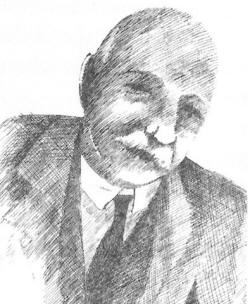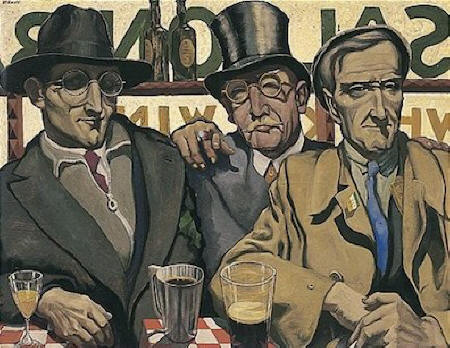

Partner Thomas Campbell
Queer Places:
Davy Byrne's, 21 Duke St, Dublin, D02 K380,
Ireland
Glasnevin Cemetery
Glasnevin, County Dublin, Ireland
 David (Davy) Byrne (1860
- September 10, 1938), is a Dublin institution to this day, in part because the fictional Leopold Bloom (Ulysses by James Joyce) eats lunch there in Lestrygonians. Davy Byrne's is a public house on Duke Street in the prosperous southeastern part of the central city. Bloom thinks of it as a Moral pub, because of the character of the eponymous proprietor and the benign environment he has created. Joyce may possibly have intended a polemical edge to this phrase, since there is evidence that Byrne was gay and that his pub may have served as a hangout for gay men during his lifetime.
David (Davy) Byrne (1860
- September 10, 1938), is a Dublin institution to this day, in part because the fictional Leopold Bloom (Ulysses by James Joyce) eats lunch there in Lestrygonians. Davy Byrne's is a public house on Duke Street in the prosperous southeastern part of the central city. Bloom thinks of it as a Moral pub, because of the character of the eponymous proprietor and the benign environment he has created. Joyce may possibly have intended a polemical edge to this phrase, since there is evidence that Byrne was gay and that his pub may have served as a hangout for gay men during his lifetime.
Byrne was born in Arklow, son of Andrew Byrne, Auctioner. He was a most successful businessman , and had many commercial interests in Dublin. He amassed a considerable fortune, and was considered one of the wealthiest merchant in Dublin. He was succeeded by his nephew, Mr Byrne, son of his sister, who was formerly organist at the Arklow Catholic Church. Byrne lived in Blackrock.
Coming to Dublin in 1873 as a 12-year-old boy from County Wicklow, Byrne served as an apprentice in one pub before working his way up to part-ownership in another and then, in 1889, purchasing a run-down tavern at 21 Duke Street which he reopened under his own name. His life-story thus confirms what Bloom thinks in Calypso about publicans: Coming up redheaded curates from the county Leitrim, rinsing empties and old man in the cellar. Then, lo and behold, they blossom out as Adam Findlaters or Dan Tallons. Vivien Igoe observes that Byrne was a good listener and had a way of winning friendships and retaining them. His pub became the haunt of poets, artists, writers, scholars and politicians. These included James Joyce, Michael Collins, Arthur Griffith, F. R. Higgins, Pádraic Ó Conaire, Tom Kettle, Liam O'Flaherty and William Orpen, who was one of Byrne's greatest friends. A longer list would include Oliver St. John Gogarty and James Stephens, and later writers like Patrick Kavanagh, Brian O'Nolan (Myles na gCopaleen, Flann O'Brien), Brendan Behan, and Anthony Cronin. Actors (including the famous gay couple Hilton Edwards and Michael MacLiammoir), actresses, and dancers also frequented the pub, attracted by the artistic flair of its interior. Byrne died in 1938.

In Davy's Parlour Snug: Self Portrait with Davy Byrne and Martin Murphy, oil on board painting by Harry Kernoff from the mid-1930s. Kernoff is on the left in Trilby hat and glasses, Byrne in the middle with top hat and glasses, and Murphy (a theatrical set designer) on the right in Irish cap. Source: www.artnet.com.
Census records of 1901 and 1911 retrieved by Molony show that Byrne was (respectively) not married and single. Far more remarkably, a tombstone in the Glasnevin cemetery stands atop two graves and preserves the memory of two men: of David Byrne, who died on the 10th September 1938, and of his friend Thomas Campbell, who died on the 10th March 1927. Such an inscription, in the repressively moralistic atmosphere of Ireland in the 1930s, should probably be seen as a bold defiance of conventional sexual mores. Another Thomas Campbell, a Romantic-era Scottish poet, surfaces twice in Hades—once anonymously when Bloom recalls a line from one of his poems, and again by name when he wonders about the authorship of a different poem. These references are quite definitive, and since the Dublin Campbell died in 1927 there would be no particular reason to allude to him in the cemetery chapter. Still, given Joyce's fondness for name coincidences, it is not inconceivable that he knew of Byrne's friend and obliquely acknowledged him by bringing in the poet. Evidence that Davy Byrne's pub was moral in the sense of tolerating queerness can be found later in the XX century. For most of that century Dublin was a very lonely place for gay men. A 2013 blog by Sam McGrath on the Come Here to Me! website cites one man's recollections from the 1970s, recorded in Coming Out: Irish Gay Experiences (2003): There weren’t many opportunities to meet gay people, unless you knew of the one bar—two bars, actually, in Dublin at that time, Bartley Dunne’s and Rice’s … They were the two pubs and if you hadn’t met gay people, you wouldn’t have known about these pubs; there was no advertising in those days, and it was all through word-of-mouth. The same two bars are mentioned by another gay man, George Fullerton, who is quoted from Occasions of Sin: Sex and Society in Modern Ireland (2009) as saying that in the 1960s: I never experienced discrimination as such, probably because we were largely invisible. These two bars near the Gaiety Theatre and St. Stephen's Green became known as gay-friendly starting in the late 1950s and early 1960s, along with King's, another pub in the same area that is mentioned less often. But there were two more in Duke Street: The Bailey and Davy Byrne's. The 1971 edition of Fielding's Travel Guide to Europe noted that: On our latest visit, scads of hippie-types and Gay Boys were in evidence in the Bailey, and it suggested that both that bar and Davy Byrne's, across the street, were not recommended for the straight traveller. It seems likely that the welcoming atmosphere in Davy Byrne's may have dated back to its original proprietor.
My published books: